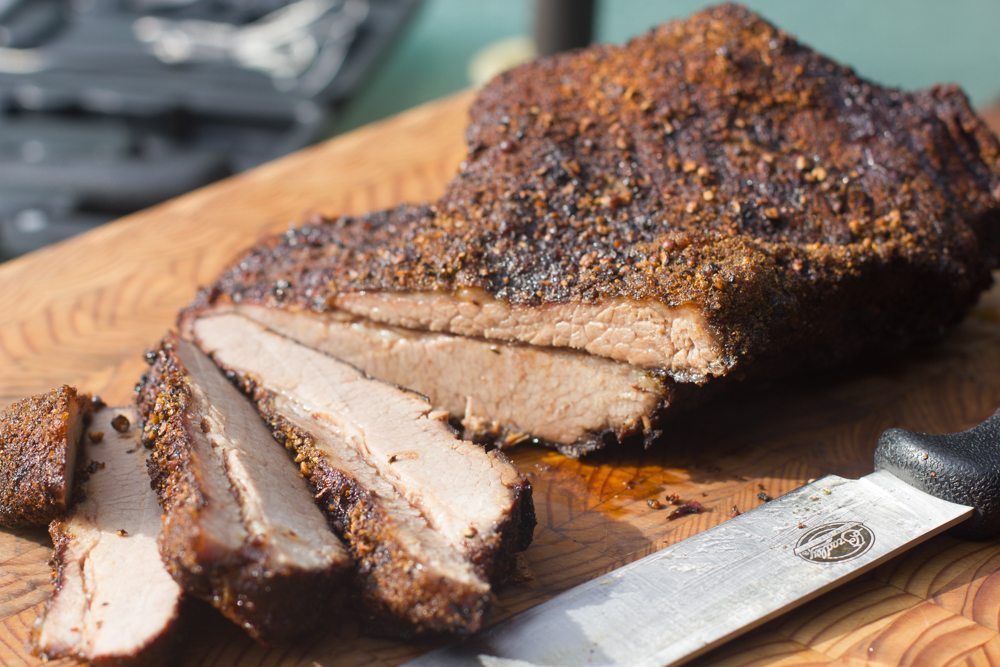Brisket is notoriously unforgiving, and can seem a little bit daunting of a task to take on. But the rewards of getting brisket right are phenomenal, the flavourful crust surrounding a tender and juicy smoked beef center.
First things first, pick your brisket cut.
Look for high quality beef with a good layer of fat. A whole packer brisket is usually on the bigger side. But the cut is ideal for smoking and makes for a tenderer end product.
If a packer cut is too bit big or unavailable the next best option is a first cut, look for one that has more fat marbled in the muscle.
Prepare the brisket
By trimming the fat cap to ¼” to ½” thick to allow smoke to penetrate through quickly while not drying out the brisket. Trim off any silver skin.
Rub your brisket in a basic rub of kosher salt and black pepper or jazz things up with herbs and other seasonings in your rub.
The rub will be the “bark” or “crust” of your brisket when it is finished. Leaving the rub on overnight allows the salt in the rub to penetrate into the brisket and help retain moisture. And more moisture means more juicy and tender brisket.
Achieving the perfect flavour and moisture
Some cooks swear by a slather on their brisket, but this is optional. Slathering your brisket in a mustard, oil, or water based sauce will impart a bit more flavour to the brisket.
But the most important component for flavour and moisture retention in your brisket will be the rub.
Brisket inject
Now, if you want to get real fancy there are all sorts of homemade and test tube derived concoctions that you can inject (yup, with a syringe) into your brisket.
These injected tenderizers and flavourings do work quite well, but the store brand solutions are often full of chemicals and to the traditionalists it’s sacrilege.
As well, most home cooks aren’t ready or stocked to perform minor medical procedures on their food. However, injecting something as simple (and chemical free) as vegetable broth into brisket can function much like brining.
It results in a tender and flavourful brisket. If you do choose to go this route, insert the needle parallel with the grain of the beef so marks don’t show when you cut into the beef against the grain.
Smoking Brisket tips
Now for the smoking. I prefer to smoke with flavourful bisquettes such as Hickory or Mesquite as beef unto itself has a strong flavour. Most prefer to smoke their brisket fat cap up in order to retain as much of the fat cap as possible, and to let the rendered fat pour over the brisket.
But smoking the fat cap down will not produce a drastically worse product. Not much fat will penetrate into the brisket by running down the sides, but it will add a little more flavour.
Smoking is all about the low and slow. Go too fast and hot and you’ll dry out the beef within the first hour. Smoking around 200-250°F appears to be preferable among experts.
If you have the extra time, take it and smoke at the lower end of the temperature spectrum. Some professionals and experts will smoke brisket at over 300°F, but that is with a recipe and a cut they are familiar and confident in. Until you’re ready and super confidant in your skills too, keep the temperature low.
Extra care
As you’re smoking your brisket give it a mop with a nice basting sauce. Even spritzing with broth or water will do the trick. Mopping your brisket keeps it moist which enhances its ability to absorb smoke, as well it will cool the surface of the meat and slow down the cooking process to create a tenderer product.
Some like to remove the brisket from the smoker when it reaches 150°F and wrap it in aluminum foil so it can braise itself. This will make the brisket more tender, but it will soften your “bark”. So if you’re worried about a dry brisket your first time around, give this a try.
Serving your brisket
Brisket is ready to be pulled out of the smoker between 195-205°F. You’ll know it’s ready when the thermometer glides in effortlessly, once it passes the “bark” of course.
Let your brisket rest and cool slightly before slicing thinly (about ¼”), against the grain, and serving.
What you decide to serve your brisket with is entirely up to you. Keep it simple or add some crazy sauces and sides, all your choice.
But always give your brisket the chance to stand on its own. If you can do that then you, my friend, have smoked one fine brisket!
Check out some mouth-watering brisket recipes





